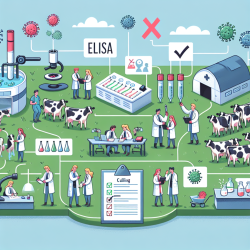Understanding Bovine Leukemia Virus and Its Impact
Bovine Leukemia Virus (BLV) poses significant challenges to the dairy industry, affecting herd health, production efficiency, and sustainability. Despite global efforts, the United States has not implemented a widespread BLV control program, resulting in a prevalence rate of approximately 40% among dairy cows. The economic and health implications of BLV are profound, with costs reaching $525 million annually due to decreased milk production, immune suppression, and increased risk of lymphoma.
Research Insights: Test-and-Cull Approach
The study titled "Control of Bovine Leukemia Virus in Three US Dairy Herds by Culling ELISA-Positive Cows" provides a data-driven approach to managing BLV. Conducted on three Midwestern US dairy herds, the research evaluated the efficacy of a test-and-cull strategy using ELISA screening of milk samples. This method successfully reduced BLV prevalence in herds with initially low infection rates, highlighting the potential for broader application.
Implementing a Data-Driven Approach
For practitioners, the study underscores the importance of regular monitoring and strategic culling. Key steps include:
- Conducting periodic ELISA testing of milk samples to identify BLV-positive cows.
- Implementing a culling strategy for identified positive animals to prevent virus spread.
- Ensuring incoming heifers are tested and free of BLV to prevent reintroduction.
These measures, while initially applicable to herds with low BLV prevalence, can be adapted for broader use with careful management and ongoing surveillance.
Encouraging Further Research
While the test-and-cull approach shows promise, it also highlights the need for further research into cost-effective methods for reducing BLV prevalence across the industry. Practitioners are encouraged to explore additional strategies, such as enhanced biosecurity measures and genetic resistance, to complement existing efforts.
Conclusion
The control of BLV through strategic culling and regular testing offers a pathway to healthier herds and improved economic outcomes. By leveraging data-driven insights and committing to ongoing research, practitioners can play a pivotal role in advancing BLV management practices.
To read the original research paper, please follow this link: Control of Bovine Leukemia Virus in Three US Dairy Herds by Culling ELISA-Positive Cows.










